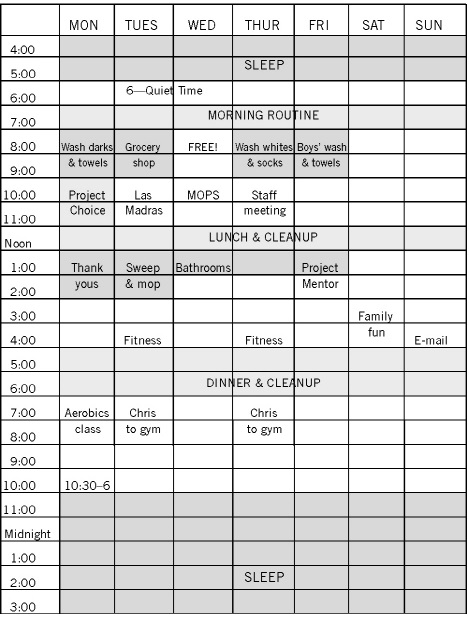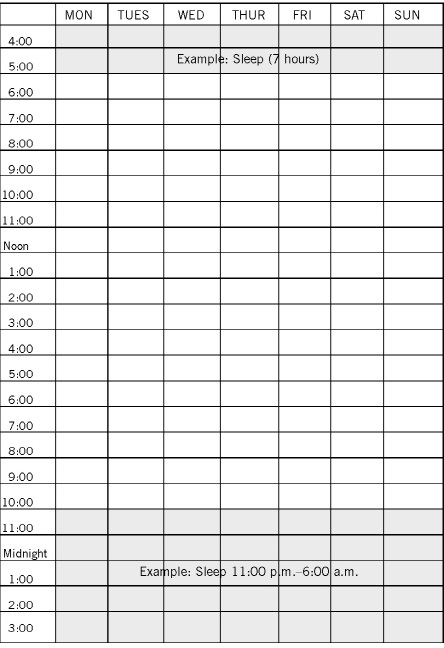

Even if you’re on the right track, you’ll get run over if you just sit there.
—Will Rogers
Once you have your time tools in place, important relationships in order, and favorite personal time activity in mind, you’ll be ready to apply one of the best skills I know to simplify your time. I call it “rhythm.” It’s a weekly ebb and flow that allows you to be at your best.
The secret to creating this rhythm is twofold. First, pay attention to how you currently spend your time. Second, intentionally choose how you wish to spend your time from now on.
Holly’s Story: “How Can I Get Anything Done?”
“Hi, Marcia. I’m so glad you’re here,” Holly said as she opened her front door. Behind Holly stood her husband, holding six-month-old Jacob as two-year-old Joel held on to his mother’s leg. They looked like happy but tired parents.
“I’m glad to be here,” I said. “And I’m ready to hear your concerns about not getting things done.” Theirs was a common complaint––one I often hear from parents of young children. I could relate, but there are time skills to solve that problem.
We moved to the kitchen with a fresh pot of tea, a pad of paper, and a pen. Holly’s husband took the boys and headed upstairs. It was Holly’s time to get some help.
Start Where You Are Now
“As you can see, the house is picked up––sort of. My husband is helpful, and the boys are really good . . . but I still can’t get to some of the things that matter, like laundry and ironing and fun stuff like decorating projects. I feel guilty all the time. What’s the matter with me?”
I touched her sagging shoulder and reassured her. “Nothing’s wrong. You’re just in the busiest time of a mother’s life, trying to juggle the constant interruptions of children with your vision of what ‘should’ be accomplished in a day. I’m here to help you make a plan that works for you.”
As Holly disclosed what she did each week, I took notes. Soon she had listed fifteen activities. Then she added another ten that she never got to.
“When you’re in a rut like this, Holly, it’s time to look at the truth––actually track on paper what you do each hour of the day. Are you willing to do that every day for a week?”
She looked dubious but agreed. I encouraged her, “Just keep the paper in one spot all day, and on the hour, jot down the main action you took. I’ll return next week to show you how to use the patterns of time in your time log to your best advantage.”
Tally Your Time in One Week
Each week has 168 hours. That would certainly seem like enough time to keep up with chores and still have a few hours for ourselves. But often it’s not, especially if you haven’t found or created a workable rhythm for daily living, including meeting the needs of young children.
Here’s how to create a time log, like Holly did:
1. Pencil in the 168-Hour Chart for the following three areas:
■ Sleep
■ Meals and cleanup
■ Primary weekly activity (e.g., work, volunteering, parenting, care-giving, etc.)
2. Color these three blocks with three highlighter colors.
3. Total the hours spent on each and write the amount in the margin.
Example:
■ Sleep (49 hours)
■ Morning routine/meals/cleanup (30 hours)
■ Primary weekly activity (50 hours) Total—129
Subtract 129 hours from 168 hours in your week, and you’ll have 39 hours left. Detail the time log in these three categories to discover where the majority of your time is going. You may be surprised.
4. Group the rest of your time in three other categories.
Example:
■ Transition time, such as drive time to work or children’s activities (3 hours)
■ Family/TV/computer time (10 hours)
■ Meetings or classes (3 hours)
Subtract the 16-hour total from the 39 hours you have left from the first three areas. This leaves 23 hours each week for projects, personal time, relaxation, and fun.
168-HOUR CHART FOR HOLLY
Holly’s Goal: Accomplish what I need to and enjoy my week! Boys 2 years + 6 months

| 1. Sleep = 49 hours | 2. Chores = 15 hours | 3. Meals = 28 hours |
| 4. Activities = 9 hours | 5. Personal = 6 hours | 6. Free = ____ hours |
Surprise, Surprise!
Typically out of 168 hours, there are ten to twenty hours of “free choice.” Holly was discouraged that she could never find that time. But once she saw how to structure her days, she was hopeful that the unstructured hours could be put to better use.
So we added time frames specifically for laundry, cleaning chores, and activities she attended.
Holly looked at her chart. “That looks so much better. I can really see where my time is going. But some of those chores I don’t want to do. What then?”
I laughed. “Now that’s a whole other session about motivation. You start by thinking of your husband, you, and the children interacting. Picture a happy, well-adjusted family. Then stick to your chart, even if you don’t feel like it, because it will make a difference in their lives and in yours. You’ll be in control of your time now that you’ve listed what you have to do and when you’ll do it. Sure, you need to adjust the schedule, but it will work more times than not.
“Use the daytime to handle chores and other routine activities. Then you’ll have relaxed afternoons and evenings to enjoy with your children and husband.”
Holly looked hopeful and happy. “I’ll try it!”
What ideas does this give you for your life? You can simplify your life by taking stock of where your time is really going. Ask yourself if your schedule is bringing you the results you want. Of course, you have to leave several hours open as free time. After you’ve done that and recognize you are overbooked or underscheduled, you can make changes. You now have the opportunity to balance your days.
YOUR 168-HOUR CHART

Find Your Personal Rhythm
Intuitively, we do certain things at certain times in the week. We fall into patterns without realizing it. Tracking our actions on paper can jolt us out of time wasters.
If you feel too many things in your life are left undone, copy the blank 168-hour chart and keep track of your time as Holly did. The simple act of writing down the main thing you do each hour will show you how much time you get distracted or spend on time wasters. Then you can create a master plan and reassign those hours to activities that add balance to your life.
Everyone has a weekly rhythm. Those who are most satisfied with life have a balance of personal time, purposeful work, and relational time. Before you fall asleep at night, think about what worked that day and what you want to improve tomorrow. You can improve every day.
It’s Your Time
Discover Your Rhythm for Each Week (Time Skill #3)
■ Track your time for one week on the 168-hour chart. Star two good things you did and two you want to improve.
■ Find your balance of scheduled and unscheduled time that energizes you each day.
He who would make serious use of his life must always act as though he had a long time to live and must schedule his time as though he were about to die.
—Émile Littré